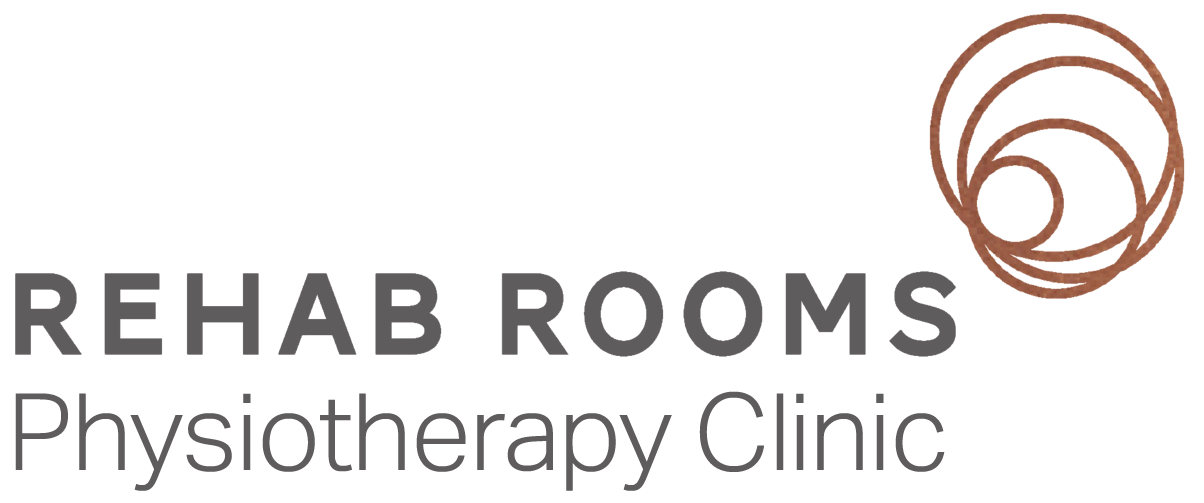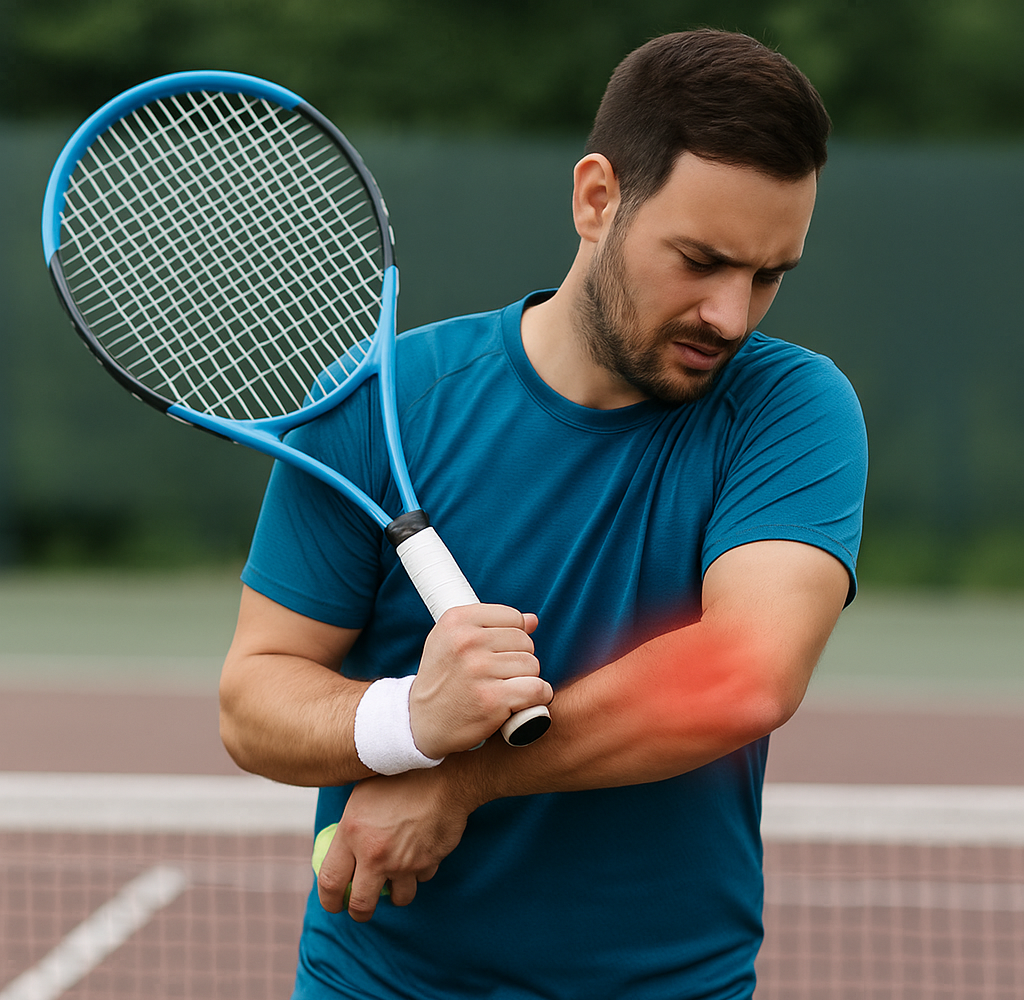I think I have Tennis Elbow – and it is really affecting my game!
By Oshin Amberkar and Alison Quinn
Physios at Rehab Rooms Physio Clinic
Introduction
With Wimbledon just started and the French Open still fresh in our minds, it’s the time of year when tennis fever grips the country. And along with it comes a spike in tennis-related injuries—most notably, tennis elbow. But you don't have to actually play tennis to also get tennis elbow.
Yes – lots of tennis players get tennis elbow – in fact it's one of the most common injuries in tennis. But despite its name, you don’t need to play tennis to get it—any repetitive activities that overload the muscles and tendons around the elbow joint can lead to this condition. We’ve treated golfers and swimmers with tennis elbow. We’ve treated those DIY enthusiasts after a weekend of hammering or painting left them with elbow pain.
Tennis elbow, or lateral epicondylitis, is a common condition that causes pain and tenderness on the outside of the elbow. Sometimes you can even get other symptoms like pins and needles in the hand or neck pain but more about that later....
We’ve seen a lot of tennis elbow in the past few months in the clinic, with the better weather and the longer evenings as people take to the court, the course or the back garden shed!
Let’s take a closer look at what causes tennis elbow and more importantly how to get it better.
So what does tennis elbow feel like?
It usually starts with a bit of a niggle in the outside of the elbow when, say. you hit a shot in tennis or golf. Then it gradually gets worse over time and you then start getting pain on everyday normal activities like lifting a kettle of water or even a mug of tea. Your grip strength feels weak and you start dreading when someone might give you a firm handshake! The outer part of your elbow near that bony bump (the lateral epicondyle – hence the name lateral epicondylitis) starts feeling sore to touch and if you hit it off anything it hurts like hell. Then you might start getting tight in your forearm or feel mild pins and needles in your hand. Your neck might feel stiff.
So what causes tennis elbow?
Tennis elbow is basically an aggravation of the tendon on the outside of the elbow – the tendon that attaches the forearm muscle to the arm. It can happen with a sudden injury like accidentally hitting very hard ground in a golf shot but more than often than not its caused by overuse i.e. an injury caused by repeating the same motion over and over again causing the structure of the tendon to get aggravated and weak – tennis shots, golf shots, painting, hammering. People that work in jobs that require repetitive wrist and elbow movements can be prone to tennis elbow – typists, plumbers, carpenters, chefs.
A bit like joints, tendons are also prone to wear and tear as we get older so this can also contribute to pain. The most common age group to get tennis elbow is mid thirties to mid fifties.
Finally technique or sports equipment can play a role – we had a patient who used a different raquet one weekend with tighter strings and it make the elbow sore. We’ve had patients who over grip golf clubs and tennis clubs because they might have a shoulder injury that they are trying to protect so they put more pressure on their elbow.
We mentioned pins and needles and neck pain above – often we see these co-existing with tennis elbow. Sometimes things we have been doing for years like sitting slouched looking at laptops and phones (sound familiar?!) can cause the neck to be in a flexed position for long periods and the shoulder joint and pec muscles at the front of the chest to get tight. These in turn may put strain on neck joints, discs and nerves that come out of the neck and into the arm. This may then alter the load put on the neck, shoulder when playing sport or doing activities, which then may overload the elbow tendon. So not only do you have a tennis elbow but you also have a bit of nerve irritation. We see this all the time in clinic.
How we Approach Tennis elbow treatment and rehab
Step one – assessment - we find out what is causing this problem – we take a take a detailed assessment. We can assess elbow strength using a hand held dynamometer, mentioned in our recent shoulder blog. This gives us an objective measure. Often in tennis elbow the affected side is 30-50% weaker than the other side. This gives us a good place to start. We also look at the tendon and forearm – how does it feel, where is it sore? We’ll look at the range of motion in the elbow joint but we’ll also look further afield – what's going on with the shoulder and the neck and upper back areas, are any of the nerves irritated?
Step two – plan and goal – we fit the treatment around what's important to you, because that IS the most important thing. What's your goal? Do you have a match coming up or do you need to get back to work or do you just want to lift up a mug of tea without pain. We make the plan based around your goals and explain how we’re going to fix this and roughly how long it's going to take.
Step three – de-load the tendon – this is so important in tendon injuries and often forgotten. You need to stop aggravating the tendon, you need to stop or modify things that you know are causing you pain. Unfortunately, depending on how bad the pain is, that may mean a break from sport for a while or you may need to modify how you play – for example, play 9 holes instead of 18. Putting on a support like an elbow strap may allow you to continue to work or play without further aggravating the tendon. You may need to take over the counter medication just to let things settle and ease the pain. Other treatments like dry needling for tight muscles, taping to help off- load the tendon may help. At Rehab Rooms we love manual therapy! So working into the tissues of the forearm, tendon or a tight shoulder joint can really make things feel more flexible and freer.
Step four – load the tendon – as the pain settles we now need to get this tendon used to working again and taking load, but in a controlled way. We know the strength of the tendon is less than the other side so we need to get it back to that strength using weights but in a controlled way. This process may take weeks or even months but once you know that you won’t get frustrated with it. You may not need to be off work or sport all this time but it may mean modifying your activities and gradually adding in more as the tendon gets better.
Step five – what else do I need to fix? At this stage we’ll look at other factors that might be causing the issue – is the shoulder stiff, is the neck stiff, is the upper back weak and not doing enough to support your elbow. All of these factors have to be looked at to ensure your whole trunk and upper limb has the strength, flexibility and control to do what you need it to do and more importantly that you are confident to do it. Do I need to look at my equipment – is the raquet a bit heavy for me, do my golf clubs need new grips? Take a trip to some of the specialists for example Grandstand Sports in Dun Laoghaire or McGuirks Golf to get your equipment assessed. Do I need a lesson from a professional to adjust my grip instead of repeating the same bad habits over and over again?
Bringing Research Into Rehab
We recently did a study with RCSI where we tested a well researched and successful treatment and rehab protocol for another commonly injured tendon – the glut tendon at the side of your hip. The same lessons for treating this tendon can be used for treating the elbow tendon:
De-load the tendon by stopping things that aggravate it – like lifting heaving objects
Then load the tendon gradually with weight bit in a controlled way
Fix any other biomechanical factors that might be contributing to the problem eg stiff shoulders/pec muscles
The main message – keep it specific for the patient and keep it simple – not 10 exercises that may or may not hit the mark – 3 or 4 key exercises that get this tendon to behave itself!
To Anyone Dealing With Tennis Elbow
Tennis elbow can be really debilitating and can stop you playing well loved sports like golf and tennis but it can also affect your daily activities. They are slow burners but they get there (eventually). The important thing is to stick with the plan and the graded increase in exercise and the vast majority of tennis elbows resolve. You’ll be back to your sport and activities before you know it, pain free, knowing what to watch out for and how to stop it returning in the future!
Take the First Step
At Rehab Rooms, we believe that successful treatment is down to accurate diagnosis and assessment, which leads to successful treatment outcomes. We don’t just treat the joint—we work with the person. Whether you’re newly injured, dealing with long-term pain, or rebuilding after surgery, we’ll guide you through a clear, structured plan that’s built around your life, your needs, and your goals.
If your elbow is holding you back, let’s fix it—together.
Book online now by clicking here or call us at 01 430 5634 or email us at info@rehabrooms.ie to schedule your assessment.



